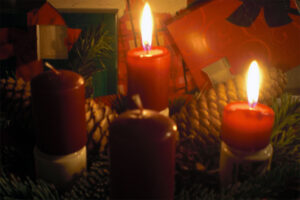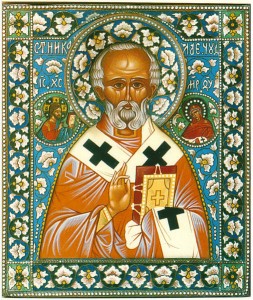By Professor Carol on Dec 06, 2015 04:00 am

onnola (CC BYSA 2.0)
This year, the Second Sunday of Advent coincides with St. Nicholas Day (December 6). While both are significant dates on the liturgical calendar, it’s pretty clear which one has taken over the popular culture.
In considering how to combine these topics, I tried to rid my mind of an image where Santa Claus runs into the room to light the Second Advent Candle. Yet isn’t that what we see around us today? What about those pictures where Santa stands at the Nativity Scene in Bethlehem, tucked right next to the shepherds and Three Kings? I realize that these images result from the desire to blend together the disparate streams of sacred and secular celebration at Christmas, but it doesn’t work.

Nicholas de Myra
Again, celebrating Advent helps here. St. Nicholas was an actual person from the early 4 th century. His journey from Bishop of Myra to Jolly Ole Nick is documented in many places (including in a colorful entry we ordinarily post here for December 6). You might also enjoy the pages of the St. Nicholas Center. But today, Nicholas’ day is overshadowed by the more important liturgical date of the Second Sunday in Advent.
Lighting that second purple candle and returning again to the readings, prayers, and conversation that was begun last Sunday brings Advent into stronger focus. Why? Because it is a both a repetition of something we’ve started, and an amplification of it. One flickering light has become two. The circle-shape of the wreath comes into view. The realization dawns in even young children that, “Wait, next time we’ll light another candle, and then another, and finally the white candle will be lit.” And at that point, something special will have been accomplished in their understanding of tradition.
Repetition, variation. Are these not two of the most powerful aspects of human life? Yet, repetition per se has gotten a bad name somewhere along the line. In today’s culture, we forego repetition, and seek out the new as more gratifying. Often we view repetition as a consequence of having failed in our first attempt at something.
Yet repetition is the most crucial element of learning. Think of how many times a toddler wants to hearGoodnight Moon over and over, for example. Does a little child ever tire of singing Itsy-bitsy Spider or playing London Bridge? Repetition in these early stages of learning brings confidence, strengthens understanding, and increases joy.
Repetition is a key ingredient of art and worship. In art, we find form in a piece of music by hearing the repeated sections, often a repetition with some variation. We delight in the repetitions of a poem’s rhyme scheme. The repetition of patterns engages our eye, whether it be the design of a quilt or the flash of a screen-saver.
More fundamentally, our lives in worship are lived in a series of repetitions. We honor God’s commandment with the seven-day week and a repeated observance of the Sabbath. We rejoice each year at Christmas to repeat those traditions that we find most meaningful, to tell the same stories, to place the same Nativity Scene in its honored spot, to prepare the same meals. By all means, this is the day to retell the story of St. Nicholas.
The ceremonial lighting of the second candle is traditionally performed by the oldest child. That child will first light the candle that was lit on week one, and then will light a second, purple candle. This becomes a repetition of last week’s ceremony with a new variation. And yes, there are prayers designed for this Sunday, like this one:
Merciful God, who sent thy messengers the prophets to preach repentance and prepare the way for our salvation: Give us grace to heed their warnings and forsake our sins, that we may greet with joy the coming of Jesus Christ our Redeemer; who liveth and reigneth with thee and the Holy Spirit, one God, now and for ever.Amen.
In observing the tradition of Advent II, we unite with millions of Christians going back hundreds of years. It’s a repetition, but it becomes new, because it is being done by you and your family.
Our lives flourish with repetitions of the good and the beautiful. For that matter, depending on how you incorporate Santa Claus into Christmas, even something like anticipating the Santa float at the end of the Macy’s Thanksgiving Parade can teach the importance of tradition.
But we need the repetition of sacred actions, even in the smallest form, to bring substance and beauty into the spiritual life. Do not doubt their importance. You can be confident that your children will mark them well and learn the things you honor by observing these repetitions of worship in your home.
Read in browser »
 
Recent Articles:
|
No comments:
Post a Comment